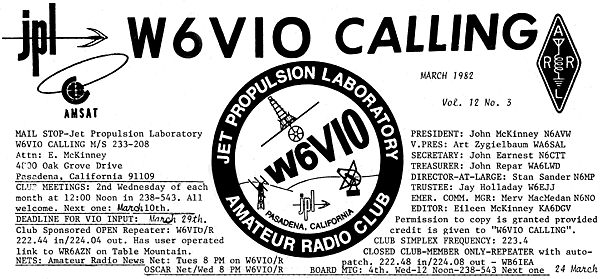
JPL ARC Board for 1982
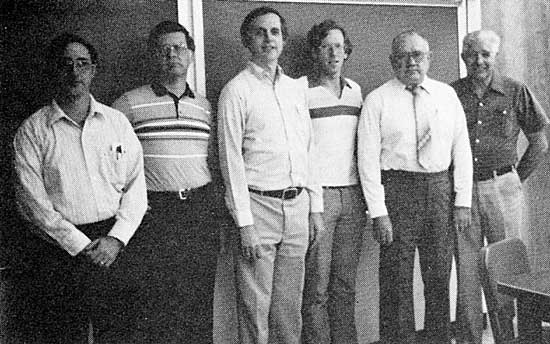 |
| Pictured left to right are John McKinney - President, Merv MacMedan - Emerg. Comm Mgr., Jay Holladay - Trustee, Stan Sander - Dir. at Large, John Earnest - Secretary, and John Repar - Treasurer. Art Zygielbaum - V.P. is not pictured. (Photo by Norm Chalfin K6PGX) |
The next two months
should see a completion of the Club's Voyager II Commemorative Activity. The
QSL cards are due back from the printer this month and the finishing touches
are being put on the SSTV cassette tape containing slow scan pictures selected
as the best of the thousands returned by the Voyager Spacecraft during last
year's historic encounter with the planet Saturn. (This tape will be made
available to SSTV enthusiasts for a nominal charge.) The commemorative netted a
total of about 8000 contacts and demonstrated that public interest in the space
program is alive and well.
The big task at hand is to get all those QSL
cards mailed. It is a mammoth effort which will be orchestrated by our new QSL
Manager Bruce Beaudry, WD6HEZ. Bruce stepped in for Ron Zenone, W6TUZ, who had
done an outstanding job for the Voyager I Saturn encounter. Bruce will be
contacting club members for assistance in preparing the QSL mailings. Letís all
pitch in and help and keep the delay to a minimum. A lot of anxious Hams who
have waited patiently for many months wonít be disappointed by this outstanding
QSL card.† (John N6AVW)
Attendees: John
McKinney*, John Earnest*, John Repar*, Jay Holladay*, Merv MacMedan*, Stan
Sander*, Norm Chalfin, and Jim Lumsden. (*=Board Member). Last board meeting
minutes read and approved. John Repar reported that 85 members have paid dues
to date and funds have been received from autopatch members also. He will have
a treasurer's report for the next meeting.
John McKinney stated
that we must resubmit our ERC funds request. He also passed a letter around
from a student requesting SLOW SCAN info and a response was formulated.
Stan Sander has edited
the script for the Voyager tape and it's been forwarded to Dick Piety. Jim
Lumsden stated that Voyager QSL cards should be printed by 22 March.
Off Lab Members voted
in were Bill Carpenter WA6QZY and Maurice Piroumian WA6OPB.
Jim gave the
Facilities Report for Jack Patzold and stated that antennas had been removed
from one water tank to permit work of the tank roof. Jim also gave report on
repeater activities, such information to be covered elsewhere for members.† (John N6CTT)
†(Editor's Note: John Earnest N6CTT has done a
terrific job as Secretary. He has the minutes of the Board Meetings to me
within a day or so of the meeting and that is why you now have a current Board
Meeting Minutes Section. The alternative would be the minutes a month after
they happened. Thank you John - you make my job lots easier.)
ATTENTION! LAST MONTH WE LEARNED ABOUT SPECTRUM ANALYZERS. THIS MONTH WE WILL HEAR ABOUT ONE APPLICATION TRULY OUT OF THIS WORLD. DR. ED OLSEN, A STAFF SCIENTIST ON THE SETI PROJECT WILL TELL US ABOUT SETI AND RFI OBSERVATIONS AT DSS14. THE MEETING WILL BE HELD ON MARCH 10TH. AT 12:00 NOON.†† (Stan N2YQ)
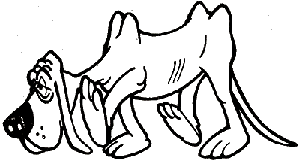
When my parents named
me they never gave me a middle name. I'm sure if my mother could have foretold
the future it would have been "Fido" or "Rover" since the
doghouse is my usual home.
You'll notice that
this month "VIO Calling" is done with a word processor. They're the
way to go I was told. Don't believe it! I was ready - my courage was set
as I approached the room that held the mechanical monster. John told me it was
easy. A child could program it - any fool could learn well he didn't come
to grips with the kind of fool he was dealing with. I sat at the table -
he turned the "thing" on and it was instant hate. I never said a word
and yet I could see the hate in it's little display screen. I pushed the
"display" button and it blinked "TRY AND MAKE ME" pushed
the "control" button and it started to beep obscenely. I pushed the
"delete" button and it blinked "DELETE IT YOURSELF". I
pushed a "wrong" button and it beeped "TRY AGAIN DUMMY". I
pushed the "print" button and it started berserking out.
John ran into the room (I never knew he could move that fast) and yelled "What did you do?" I sat there screaming "Help me please" and whose part do you think he took - well we all know it wasn't mine. He hugged the computer and told it to calm down and then patted it's disk drive. Now he hasn't patted my disk drive in years. The war was on - the computer or me. It'd be a fight to the finish. He unjammed the paper as he glared at me and realigning the printer told me not to touch anything as I leaned on a button. Of course he was just a few seconds too late - as the printer head whirled across his knuckles printing Editor Eileen McKinney. His face turned a NASTY shade of blue as I ran for my life out the door, In the background I could hear "BEEP BEEP GOOD RIDDANCE BEEP BEEP". Well what can I say? John goes to work tomorrow and we'll be alone here. Just her and me and my wrench and screwdriver. She'll beep no more at my husband. (Eileen KA6DGV)
Advertise
now in the classified section
FOR SALE: 2M FM Gear,
rock-bound, in top shape with lotsa rocks. (1) Wilson 1405 HT, 1&5
watts, desk charger, holster, duckie, Touch tone pad, PL on Tx. $150 or offer.
(2) Standard SR-C 1400 22-ch, 10 W, 12 V mobile; includes:
"WATTS-UP" 50W Linear, mike, 5/8 ground plane, external dry-cell
battery case. $90 or best offer. Al Chapman, W6MEO, 1267 Martha Way, Santa
Rosa, Ca 95405 (707) 542-3402.
ANTENNAS: Larsen
mobile antennas and KLM beams. Midland mobile speaker with mini-plug for
use with IC-3AT, 13-509, 13-513, or FM-76, $10-55.
Call Walt, WA6PEA, eves. at 248-7525.
The Club Newsletter is
now being produced with the aid of a word processor. You can reduce the typing
load by submitting your article in a CP/M compatible file on a single density,
single sided 811 floppy using standard IBM format. Files generated using the
"Wordstar" word processor can be accepted. Your file will be copied
and your floppy returned to you. If you don't have access to a word processor,
please just submit as usual either handwritten or typed.
I've begged and
pleaded and even shouted please-so won't you send an article before I
ruin my knees.† (Eileen KA6DGV)
During a recent
internal inspection of the water tank holding up a couple of W6VIO's Station
Antennas, it was noted that the "ceiling" looked more like a star map
of the Milky Way!
With some very
judicious "soft shoe" walking on the tank top, Jack (WB6TXG) and Jim
(WA6MYJ) removed the fixed-point tri-bander and 80 meter dipole
antennas from the tank. The 40 meter "sloper" dipole has been
slightly moved, but is still functional. After the tank is refurbished, the antennas
can be reinstalled. Meanwhile, be cautious when selecting your antenna at the
shack. (Jim WA6MYJ)
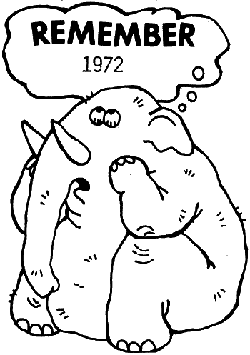
It's
1972 - Remember when -
Al Chapman (W6MEO) was
President.
Dick Piety sold a
tower and was paid for it by a check he cashed and months later the tower was
still in his backyard and Dick couldn't remember who it was that bought the
tower (they never came back).
Norm Chalfin K6PGX was
looking for parts for AMSAT/OSCAR AO/B encoder in "VIO Calling".
During Apollo 16, the
Club conducted a commemorative operation with the distinctive call sign WP6JPL,
with the entire activity being run from Goldstone. Almost a thousand contacts
were logged.
Sam Weaver (WN6EMO)
was our QSL Bureau Manager.
Gordon Crawford
(WB6DRH) was the Chairman of the Education Committee.
Tune
in next month for Remember When It Was 1973? (Eileen KA6DGV)
At the recent SMA (220
Spectrum Management Assoc.) meeting George Morris (W6ABW) was elected President
of this organization and Randy Johnstone WB6QWR) was elected Vice President. We
know they'll both do a terrific job.
Booth Hartley finishes Iron man World Triathlon - a rugged test of endurance along the Kona Coast of the island of Hawaii. This event took Booth 14 hours and 7 minutes to complete. It consisted of swimming 2.4 miles in the open ocean, pedaling a 10-speed bicycle 112 miles along the coastline and then running on a 26.2 mile marathon. Booth our hats and our tennis shoes are off to you.

Approximately 35 people
from HANDI-HAM System's Radio Camp visited JPL on Monday morning January
25, 1982, They were welcomed to JPL by Club President, John McKinney in Von
Karman Auditorium. They viewed the multimedia presentation "Jupiter the
Jewel, Saturn the Gem", showing the Voyager I and II Flyby's of Jupiter
and Saturn. Following the show they toured the Von Karman Spacecraft Museum.
The blind people were able to touch many of the exhibits for new insight into
spacecraft. While in the museum they heard talks by Dr. Louis Friedman of the
Planetary Society, Jay Holladay (W6EJJ), Stan Brokl (N2YQ), and George Morris
(W6ABW) concerning their involvements with JPL space programs.
The HANDI-HAM
System's Local Radio Camp was sponsored by Courage Center of Golden Valley,
Minnesota. Courage Center is a nonprofit organization providing medical and
vocational rehabilitation, recreation, sports, camping, educational programs
and residential services to people with physical disabilities and speech,
hearing and vision impairments.
The group visiting JPL
included handicapped students, faculty, and staff of the Radio Camp. The
students included those working on a novice license and those upgrading to
higher classes of amateur licenses. The staff and faculty including local
participants and people from Minnesota. Students came from a wide area
including, several from Tucson, Az. Many had worked W6VIO during the last
commemorative.
The visiting group was
led by Bruce Humphries (K0HR) who is Director of the Courage HANDI-HAM
System. Following the museum tour the group ate lunch on the JPL mall and
conducted a class before returning to camp.
It is truly
inspirational to see the effort these handicapped people put forward to be part
of the amateur radio hobby. Congratulations to the leaders and workers from
Courage Center who have made this possible. (George W6ABW)

The Pasadena Radio
Club, in conjunction with Los Angeles ACCESS, will be giving Novice/Technician
License Classes starting March 1st. and running through June 7th. The 15
sessions will be held Monday evenings from 7 to 10 PM at L.A. ACCESS, 2531 Nina
(near Altadena Drive), Pasadena. The fee will be $10.00 - - for
further information, call (213) 795-3198. (NOTE: The next JPL ARC Novice
Class will be in the fall) (Paul K06D)
Dave Wagner, a member
of the Spring Upgrade Class, went down to Long Beach on February 11th and
passed his Technician's exam. He plans to continue in the class not only to get
his code speed up to 13+ wpm, but also wants to take a crack at the Advanced
test. In the meantime, let's all welcome KA6OXU/LB to the repeaters. (Paul KO6D
The second group of Club Novice Class graduates have now received their licenses from the FCC. They are:
| KA6SRP | Kees Schmeitink | La Canada | |
| KA6SRQ | Joe Dominguez | ||
| KA6SRR | Thompson Lee | Cerritos | |
| KA6SRS | Joe Wackley | San Gabriel | |
| KA6SRT | Don Burcham | La Canada | |
| KA6SRU | Jose Endara | Cent. Pasadena | |
| KA6SRV | Rey Nicula | Tujunga |
Big Brothers are
needed to assist our new hams to get rig on the air and to overcome the
nervousness of their initial QSO's. A number of Club "regulars" have
already been paired-up with one of our new Novices, but volunteers are
still needed. If you are willing to help, please call John Walsh (N6UK) X-3303
or Paul Goodwin (K06D) X-4820. (Paul KO6D
TWO
MORE JOIN OUR GROUP - Welcome to two new licensees KA6RHH Leona McKinney
and KA6SUG Nob Yamane.† (Rick McKinney-KA6DAN)
Want to operate with
an XE2 call, see an exciting race, and fit in some camping and exploring in a
single outing? This is possible at least three times a year when SCORE conducts
their Baja races. These races are run over the worst roads in Baja and with
almost every kind of motorized vehicle. The roads are so torturous that usually
less than half of the entrants are able to finish. In fact, to finish a race is
considered a big accomplishment. These races are very long (from 250 to 1000
miles) so it is necessary to set up several check points around the course to
log the vehicles through these check points and to handle any sort of
emergencies.
Amateur radio is a
critical part of these check points. It is the hams job to relay all messages
and passing times of race vehicles to net control located at race headquarters.
To do this, it is necessary that the amateur operator set up stations using
forty, eighty, or two meters and to maintain reliable communications to net
control throughout the event. This is sometimes a challenge due to the
roughness of the terrain and the remoteness of some of the check points.
While helping with the
race is the reason (excuse) for being in Baja, what better opportunity to fit
in some camping and exploring. You have your communications with you (legally
too) so it is possible to coordinate any kind of travel or exploration in that
relatively unpopulated area. On several occasions, other hams and myself have
taken advantage of this situation to enjoy this very unique and unspoiled part
of Mexico.
On one such outing in
June of 1978 (also written about by Booth Hartley Aug 78 VIO Calling) several
friends were able to go on widely diverse trips and still meet at prescribed
times and places with a precision that was unbelievable. The adventure began
with Jim WA6KPW and myself driving about halfway down the peninsula and
catching Booth N6BH in his plane on 220. Booth landed the San Ignacio air strip
a few minutes before we pulled onto the field. After some preliminary
reconnaissance from the air, we drove up a very remote canyon then hiked
several miles to locate some little known prehistoric cave paintings. Following
this safari, Booth flew out to find gas for his plane and we in our cars headed
for the beach where we had planned to meet some other ham friends camped there.
On the way to the beach we again contacted Booth and arranged to meet him at a
strip that was in the vicinity. Again by virtue of amateur radio we were able
to drive onto the field within a couple of minutes of his landing. We then
joined our friends Dick WA6JBZ and Steve WB6MJK at the beach where we devoured
a delectable dinner of fresh fish just caught at this beautiful camp spot.
The next day Booth
flew back to the States and the rest of us set out to explore some of the back
roads of Baja. During two days of sightseeing in the back country, our three
vehicles were never out of communication even though we were sometimes miles
apart. At one of these times, we heard Jim calling for help. His jeep had
caught fire. We were too far away to help him, but fortunately he had a good
extinguisher and was able to get the fire out before there was irreparable
damage. After making necessary repairs on Jim's jeep, we continued on and arrived
at our designated check point for the race. While setting up our station we
again heard a familiar voice on 220. Booth was back in the air with a passenger
he had picked up in the States. We met them as they were landing the plane on a
nearby dry lake. The now sizable group of hams did our duties at the checkpoint
which included coordinating an air evacuation of a casualty of the race.
Everybody then headed home in the different vehicles reminiscing of our many
experiences in just one week of hamming and camping in Baja.
Any venturesome hams
who are interested in helping at the races and exploring Baja should contact
BARRA Baja Amateur Radio Racing Association at (714) 777-3694. (Don
WA6SQF)
Robot Access Procedures
Told - Although the story authored by G31OR in the June/July 29RO ORBIT
has been an enormous help in coming to understand the nature of the new RS's,
some updates are needed. For example the format for accessing the robots on RS-3,
5 and 7 is different in a small but critical way. The procedure for accessing
is exemplified as follows assuming your callsign is G31OR and you wish to
access RS-5
First you must listen
for RS-5 to call CQ on its robot beacon frequency of 29.331 Mhz. When you
hear it, tune your 2 meter transmitter to about 145.830 and send a series of
dots. When you hear your dots being regenerated from the downlink of RS-5,
you'll know you are within the capture range of the robot receiver. Then begin
your call as follows: "RS5 de G31OR ARII If successful the RS-5
robot should respond as indicated below. Try to send clean CW at about the same
speed you hear the robot. Apparently you need not be too accurate because the
robot will adapt to your speed after a short training period. K1HTV reports the
robot can slew from about 20 wpm to about 20 or 2w5 wpm. If the robot did not
get your call clearly you may hear a "QRZ" or "QRM" or a
"RPT" In this case you should simply try again. If you hear a
"QRQ" the robot wants you to send faster. Conversely, a
"QRS" would require you to slow down a bit. It appears the robot(s)
are moderately liberal in the cw proficiency it will accept. When you are
successful you will hear the following from, say, RS-5: "G3IOR de RS5
QSO nr xyz G3IOR de RS5 QSO nr xyz OP ROBOT T U FR QSO 73 SK"
The letters
"xyz" represent a three digit QSO serial number that will be
incremented once for each QSO yielding a unique QSO number for each QSO up to
999. The transponder access is standard and anyone having worked Mode A in the
past will have no problem here with the new RS birds. Be wary at all times of
your uplink power as the new RS receivers are very sensitive and need only
perhaps 20 or 30 watts ERP for an excellent downlink signal to result. That
power level of 30 watts ERP applies to the receivers when the on-board
attenuators are NOT activated as indicated by telemetry channel MW or WW. Greg
Roberts, ZS1B1, reports that the robots will be calling CQ about once in 59
seconds when active and that should be your clue to participate. Your reports
of activities to ASR will be appreciated and the best ones will be published as
space allows.† (Norm K6PGX)
Another month, another
article!
ANGUILLA - A
long string of VPZE - operations are underway and will continue through 10
March. They have been easily workable on all bands both on phone and CW.
COCOS KEELING -
VK9YT is active from this spot through 9 March. Look for him on SSB at 7060,
14195, 21295 and 28595. On CW, he is 25 kHz above the band edge on 20, 15 &
10. On 40 & 80, he operates the lower 5 kHz of the band.
IVORY COAST -
TU2HJ has been workable between 14200 and 14230 starting at 0330Z Mondays
(Sunday evening for us).
OMAN - A4XJO
operates 7005-7020 from 0300Z. He is also on 28003 at 1400Z, which is
probably too early for the West Coast.
TRISTAN DA CUNHA -
ZD93V should be operational about 1 March. He hasn't been heard yet so I can't
give you any frequencies.
NORTH YEMEN -
G3DYY expects to be operating from 4W1 on CW for 3 weeks starting later this
month or early April. Again, no frequencies mentioned.
TRINDADE ISLAND -
PY0RR is expected to be active from 27 March for 29 days. Past operations from
here have been primarily on 15 & 20 both phone & CW.
CAMPBELL ISLAND -
ZL40Y/A has been active from here primarily after 070OZ from 14200-14220.
Some activity has also occurred at 21345 at 0000Z.
Good
Hunting! (Bob N6ET)
On Saturday morning,
January 30, the club held its fifth annual VHF-UHF Tune-up Clinic,
at the home of Miguel Santana, WB6TEB. As in the past, Mike had professional
test equipment for checking power, receive and transmit frequencies, deviation,
and spectrum purity. He also made available his technical expertise for
troubleshooting problems and adjusting equipment "to spec."
True to expectations,
a number of people who thought they really didn't have problems found out they
did, and received the proper treatment at the clinic to cure the malady. Many
rigs were found to be considerably off frequency (probably from crystal ageing
or automobile vibration,) and others were found to have low power output,
spurs, or improper modulation levels. All in all, some 10 pieces of gear were
submitted from 7 members a relatively small showing compared to previous years.
If you were one who didn't come, could you tell us why you missed this
important event? We would like to make it more attractive next year. Please
send your comments to Merv at 233-208, or give him a ring At X7004
Those who came enjoyed
coffee which was provided by Elvia, HK4CVV, donuts which were provided by the
club, and. of course, Mike provided his unique and enjoyable humor. We are very
grateful to Mike for providing this valuable service to the club and we hope
more members will take part next year. We want our club members to be known for
the cleanest signals on the band. See you next year! (N6NO)
(Excerpts were taken
from "ZERO BEAT" for this article) The ARRL National Traffic System
(NTS) starts at the local level with a section level net. The So. Calif. Net
(SCN) has four daily sessions. SCN/1 7:00 PM PST 3598 KHz (CW)
SCN/2
8:15 PM PST 3598 KHz (Slow CW)
SCN/V 9:00 PM PST on WD6AWP/R 147,045/.645 SCN/SB 9:00 PM PST on WB6RDV/R 144.58/145-18 SCN serves Santa Barbara, Los Angeles, Orange and San Diego Sections. Traffic to and from points outside SCN territory is handled by appointed liaison stations on the Sixth Region Net (RNG) which has five daily sessions at:
| 7:45 | PM PST | 3655 CW | |
| 9:30 | PM PST | 3655 CW | |
| 10:45 | AM PST | 7275 SSB | |
| 1:45 | PM PST | 7275 SSB | |
| 3:30 | PM PST | 7275 SSB |
In the Los Angeles
Section our Section Traffic Manager is Tom Eavenson, K5DY. He is also the SCN
Manager. Tom can be reached at (213) 967-9965 for information about
traffic handling and an ORS appointment.
The SCN has a NET Participation Awards Program.
| AWARD | REQUIREMENTS | |
| SCN Member | 200 points | |
| SCN Master | 1500 points | |
| SCN Senior | 5000 points |
POINT ACCUMULATION:
| a. SCN Check-in | 1 point each time | |
| b. SCN NCS | 2 points each session | |
| c. RNG Liaison | 2 points each liaison sess. | |
| d. SCN/2 Liaison | 2 points each liaison sess. | |
|
e. SCN/V or SCN/SB
Liaison |
2 points each liaison sess. | |
| f. Monthly Report to SCM | 20 points | |
| g. Making PSHR | 60 points provided 30 of the 60 PSHR points are related to SCN operation | |
| h. Making BPL | 100 points provided majority of traffic handled was in some way related to SCN operation |
A sample accumulation for one month might be as follows:
| SAMPLE CALL WX6XYZ | Points | |
| a. Checked into SCN/1 /SCN/V 40 times | 40 | |
| b. SCN NCS four times | 8 | |
| c. RNG Liaison Twice Both Sessions | 8 | |
| d. SCN/R Liaison Once | 2 | |
| e. SCN/V Liaison Twice | 4 | |
| f. Submitted Monthly Report to SCM | 20 | |
| g. Made PSHR | 60 | |
|
TOTAL |
142 |
As you can see this
Station would have his member award in two months, his master's award in ten
months and his senior award in 36 months if he maintained a monthly point
average of 142 points.
SCN also has a monthly
publication "ZERO BEAT". If traffic handling interests you, check-in
and find out how much fun it is to deliver a timely message.† (Stan - N2YQ)
(This article was
submitted by Bob W6LTC - it was printed in the Hughes ARC Bulletin -
Feb 82.)
In the hope of saving
space we've cut this down to the basics - the argument looms over whether
to protect your aluminum antenna or not and how to do it. ".... Happily, there's
a compromise. It's inexpensive, simple, relatively easy, and will protect your
investment for many, many years. It's called paint! You guys, of course, know
all about paint, but let's review a few fundamentals anyway.
First, as the aircraft
industry discovered in WWII it's tough to get paint to stick to aluminum. Clear
Krylon sprayed on directly, for example, won't stick very long - it ends
up peeling off in sheets, and it's so thin it won't wear well. What you need is
a good aluminum primer, followed by a good, thick, exterior enamel.
After assembling and
tuning your beam, cinch down all clamps and fittings and prepare a space in a
well ventilated area of your garage or back yard for the following steps:
1. Plan to do the job
on a warm dry day. Cold and moisture-laden air are enemies of a good
paint job. 70 to 80 degrees F is perfect, the lower the humidity the better.
2.
Clean all surfaces with paint thinner or turpentine (paint thinner's cheaper).
3.
Apply with a brush, according to instructions on the can, one of the following:
"DeRusto Galv-A-Grip"
made by DAP, available at Standard Brands. Light gray preferred, but color is
unimportant.
"Galvanoleum"
by Rustoleum. Hard to find anymore, it's become one of those ecologically
unacceptable products. There might be some from commercial paint houses. Very
watery stuff, easy to apply, remains tacky. You must apply finish coat within
20 minutes.
"Gutter Grip
Primer" by Sears. Also watery, tacky, clear color.
Any other product made
for aluminum or galvanized metal is probably OK. I can vouch for the above
products, however, zinc chromate might work, although it's primarily for steel
or iron to retard rust.
4. Galv-A-Grip
requires overnight drying. The other two products dry quickly, but don't seem
like it since they remain tacky to the touch. They really hold the finish coat,
however, as long as it's applied quickly. Read the label and plan ahead. Finish
with one coat of a good grade of oil-based exterior enamel, color of your
choice. I've found a light gray, not blue, seems most inconspicuous against the
sky.
A few final comments.
Stick with oil based paints if you really want a long-lasting finish.
Exterior latexes or acrylics just aren't as durable (yet). Oil-based
enamel will lose it's gloss in a few weeks, but will hang in there for many
many years, even in coastal salt air and fog. Brush on paint is a lot more
economical than spray cans and you get a good thick coat without waste. It does
take a little longer, but then a good antenna installation should be carefully
planned and not rushed anyway, right? Fight those impulses to "get - it -
on - the - air - before - the - band - closes." Do a good job. The DX will wait for you.
Tune your beam first. Don't plan on
sliding much tubing after it's painted. If you must readjust, remove the paint
carefully (paint remover, wire brush, etc.), adjust, then touch-up again.
Any bare spots will become "seed" spots, where paint will begin to
weather away.
I've never found
electrical performance to be affected by paint. There may be some paints that
might alter patterns, impedances, or something but I've never found any
However, don't paint insulators, traps, or other non-metallic surfaces.
It's not necessary, and you may indeed screw up all that performance you paid
for.
The comments here
pertain to old beams or galvanized towers just as well. You can really extend
the life of your investments by cleaning off that old oxide layer and
recoating. Paint, in fact, will hold even better on older, pitted, dull
surfaces, including weathered gavanizing. Just be sure it's clean first.
Lastly, the final superb touch is to set that cad-plated hardware aside and replace it with stainless steel. It's not that expensive. An outfit back east sells kits for most popular beams, as well as small quantities of loose hardware. Send a SASE for a catalog to: Elwick Supply Company 230 Woods Lane Somerdale, NJ 08083.
One final admonishment. For some reason, hams tend to get in an awful rush about antenna installations. They seem to want on the air time, not messy painting time. The only answer to this is to plan ahead, find a weekend or at least an unrushed afternoon, and do it right. You won't be sorry and those few hours spent painting will pay off in many more worry free happy years of on-the-air time. (Chuck Lobb - KN6H) Submitted by W6LTC.
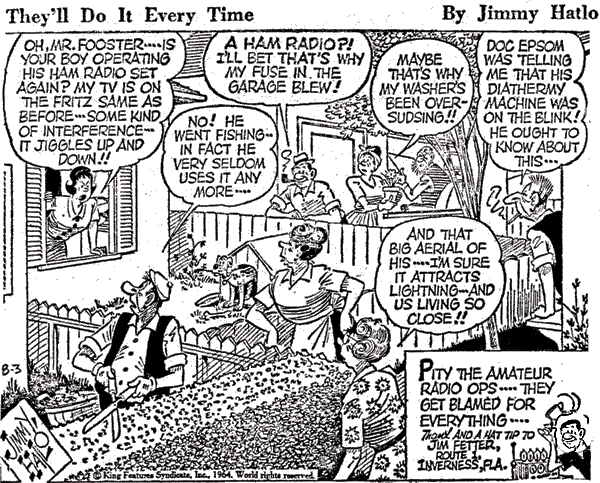
Submitted by Brian Stapleton - W6LZP (Brian had had this clipping since 1964.) He cut it out as a child.
Posted August 21, 1999